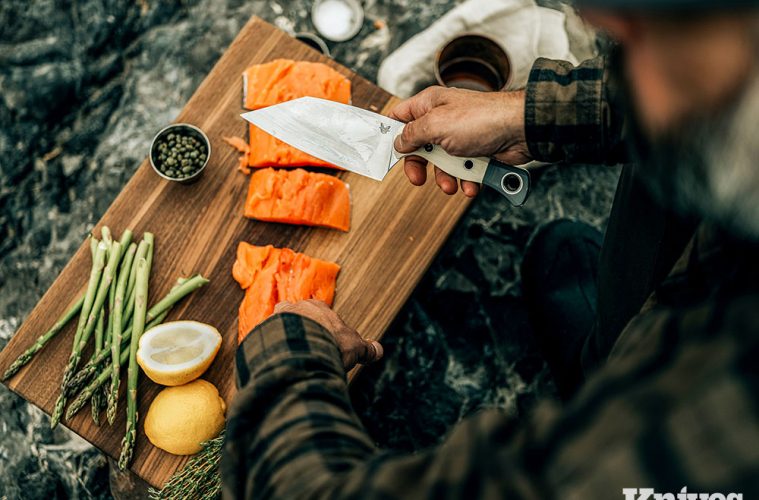GREAT AS A STAND-ALONE BLADE OR A COMPANION TO THE THREE-PIECE SET
“This station knife is one that you can carry with you that’s going to cover 90% of what you need to do, everything from preparing vegetables…to…butchering meats, slicing meats.”
There seems to be a keen interest in kitchen knives these days as many folks are staying home and preparing their own meals. Knifemakers who traditionally have specialized in tactical, bushcraft, or EDC blades are jumping on the trend and are now offering tools for the culinary arts.
Benchmade is the latest company to introduce a line of food prep blades, all of which can be custom ordered with several blade and handle options. There’s the Table Knife, Meatcrafter, and the 3-Piece Set, but the standout knife of the collection in my opinion is the Station Knife.
FIRST IMPRESSIONS
Initially handling the Station Knife only confirmed what I thought when I first saw photos of it. First, it offers the quality construction you’d expect with any knife that carries the Benchmade logo.
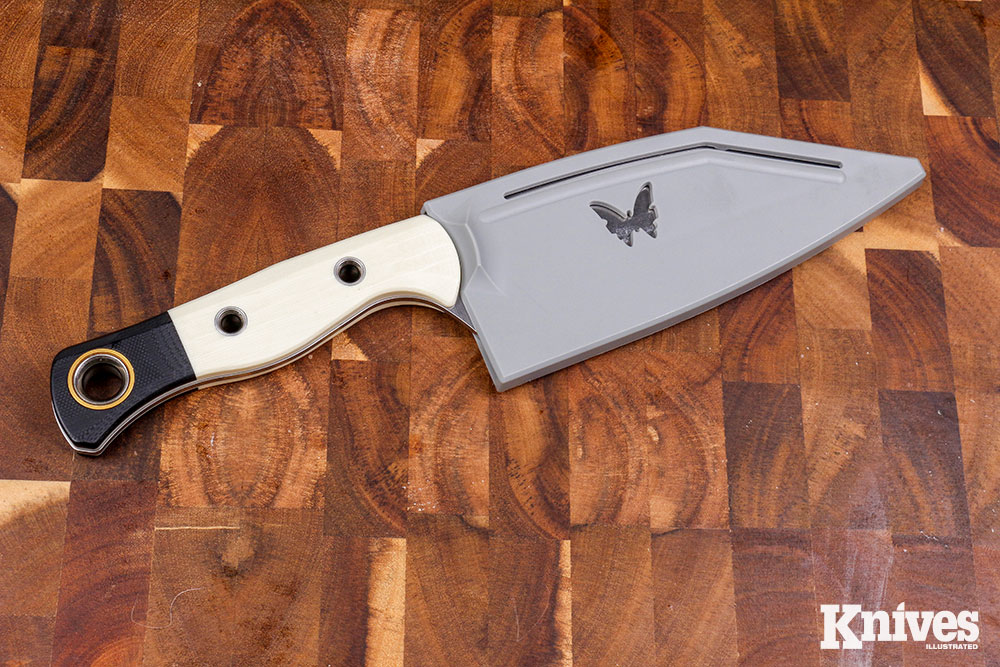
The Station Knife comes with a plastic sheath that protects both your fingers and the blade’s edge. That’s an especially nice feature if your food prep location changes from time to time. Author photo.
The knife feels good in the hand too, with excellent weight, length, and balance. The Station Knife has a full tang and is 10.88 inches overall, with a 6.93-inch blade. That blade is thin enough to slice well, but sturdy enough with only a hint of flex so it makes a good chopper.
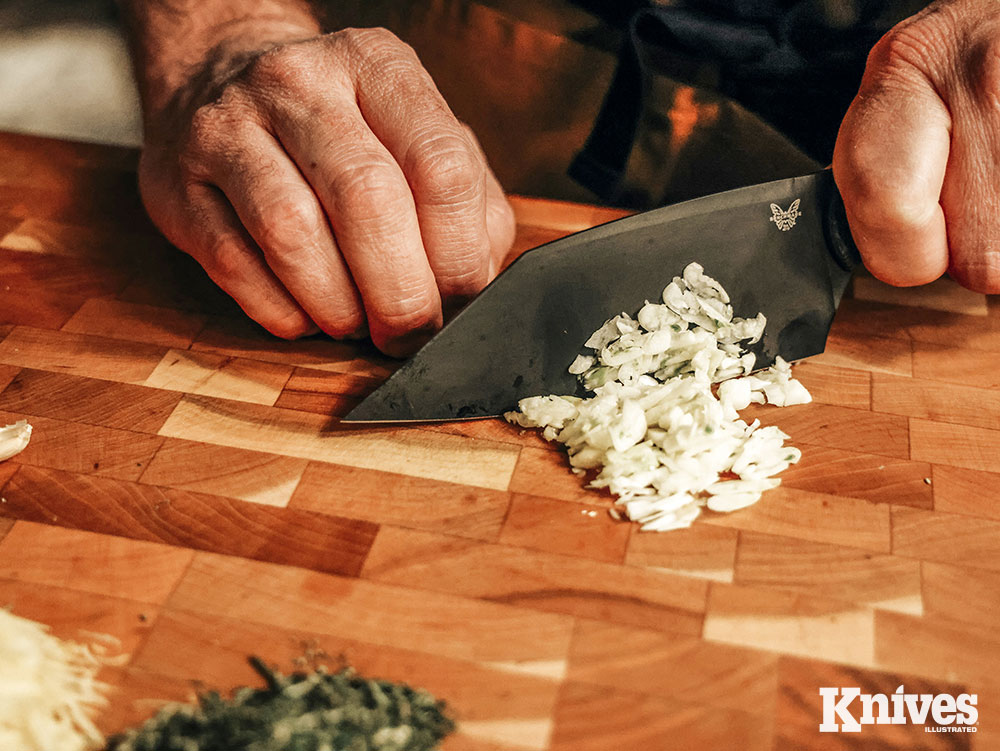
The wide, stable blade of the Station Knife helps it to perform well for dicing and chopping chores.
It measures 2.25 inches at its widest spot. That not only adds to its chopping ability, but also provides enough blade width so you can choke up on the blade comfortably and safely with a thumb and index finger pinch grip, such as you might use for fine dicing. The front third of the blade drops down drastically to a very fine point. That gives it the ability to tackle detail work you would ordinarily need to accomplish by switching to a small paring knife.
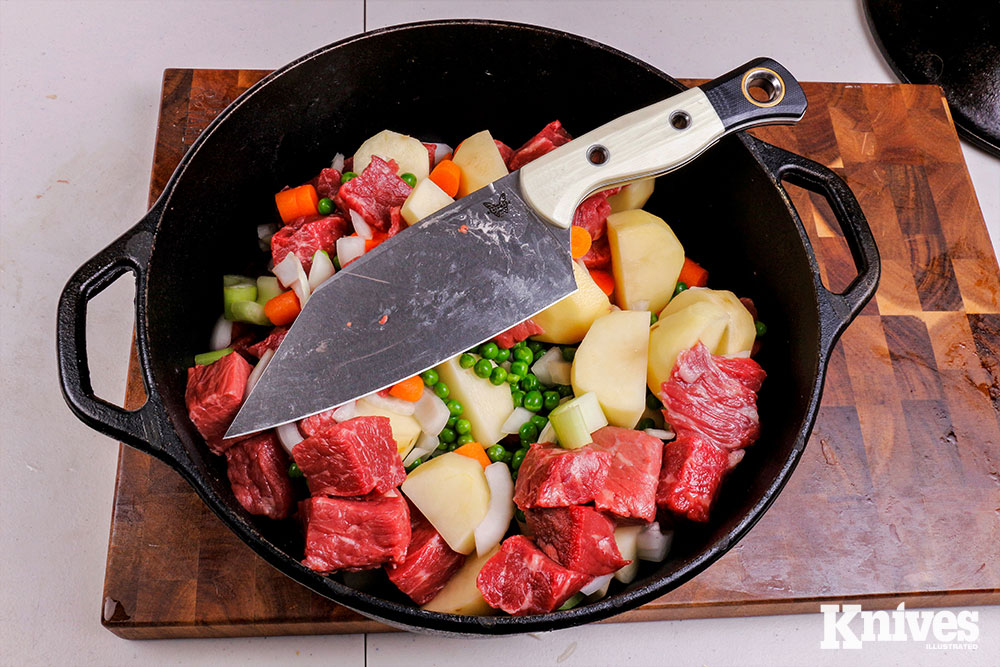
The author put the Benchmade Station Knife to work cutting meat and vegetables in preparing a beef stew. Author photo.
My particular Station Knife came with excellent CPM-154 blade steel, ivory G10 handle scales with a black G10 rear bolster, and 24K gold-plated pivot ring. It looks as good as it performs. Included is a gray plastic sheath with cutouts of the Benchmade butterfly on each side. That sheath protects both the user and the blade’s edge.
It’s a good addition to a knife that is likely to see lots of use beyond the traditional kitchen cutting board, such as at backyard barbecues, on family picnics, or tossed into a bin with camping supplies for use on a camping or hunting trip.
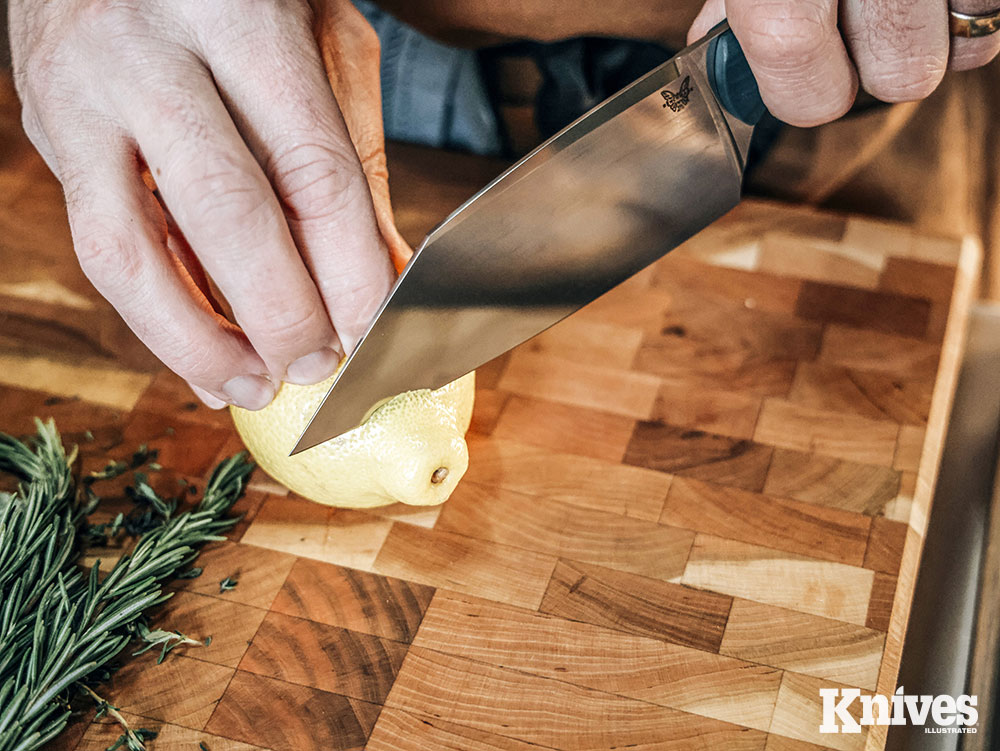
The Station Knife’s blade drops drastically to a very fine point, so it’s also capable of fine detail work.
I know what I like in a knife, but I’ll be the first to admit that while I’ve been spending more time preparing meals the last few years, I’m anything but an expert chef. I wanted to get an opinion of the Benchmade kitchen knives by someone more knowledgeable in that area.
EXPERT OPINION
Chef Kyle Mendenhall was a sounding board during the research and development stage of these Benchmade knives. He worked with the prototypes and provided his input.
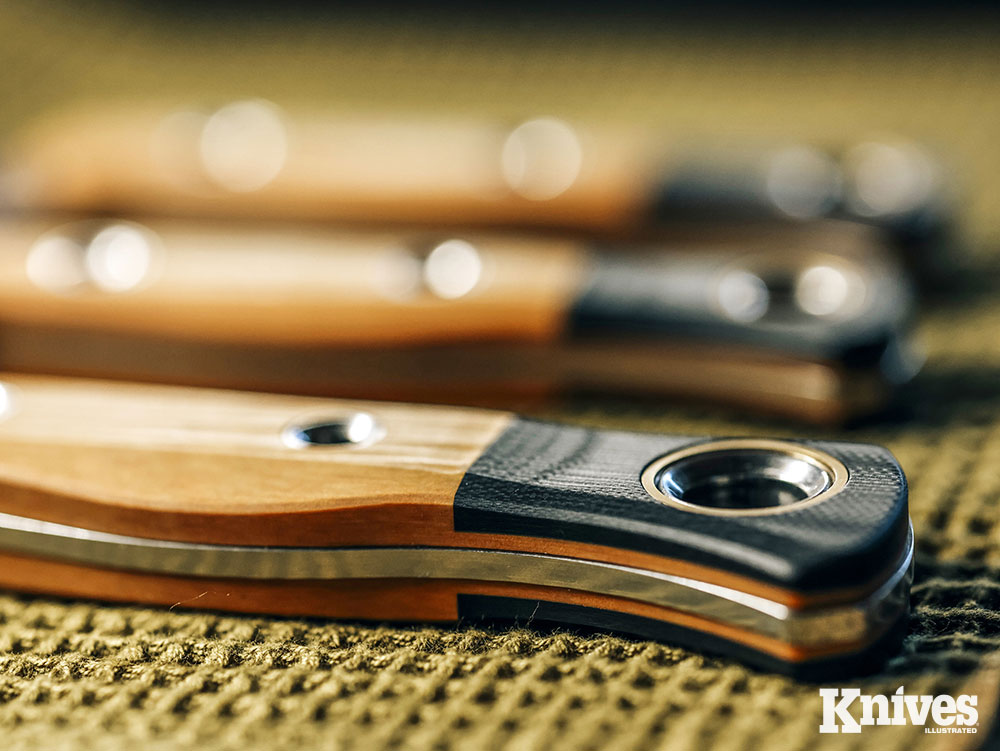
There are a variety of handle and bolster options from which to choose to suit your individual tastes.
Mendenhall, a musician turned chef, worked his way through the ranks to become the executive chef at the Big Red F Restaurant Group based in Boulder, Colorado. The Big Red F operates such restaurants as the West End Tavern, Centro Mexican Kitchen, both in Boulder, eight locations of the Post Chicken & Beer, and six locations of the Jax Fish House & Oyster Bar. The company has a catering facility and food truck as well. Mendenhall oversees 38 chefs total.
“I know that because we just got them all Station Knives for Christmas,” he said. “That in and of itself is a testament to my belief in the knife. I wouldn’t give something like that to our chefs if I didn’t think there was great value to be had there.”
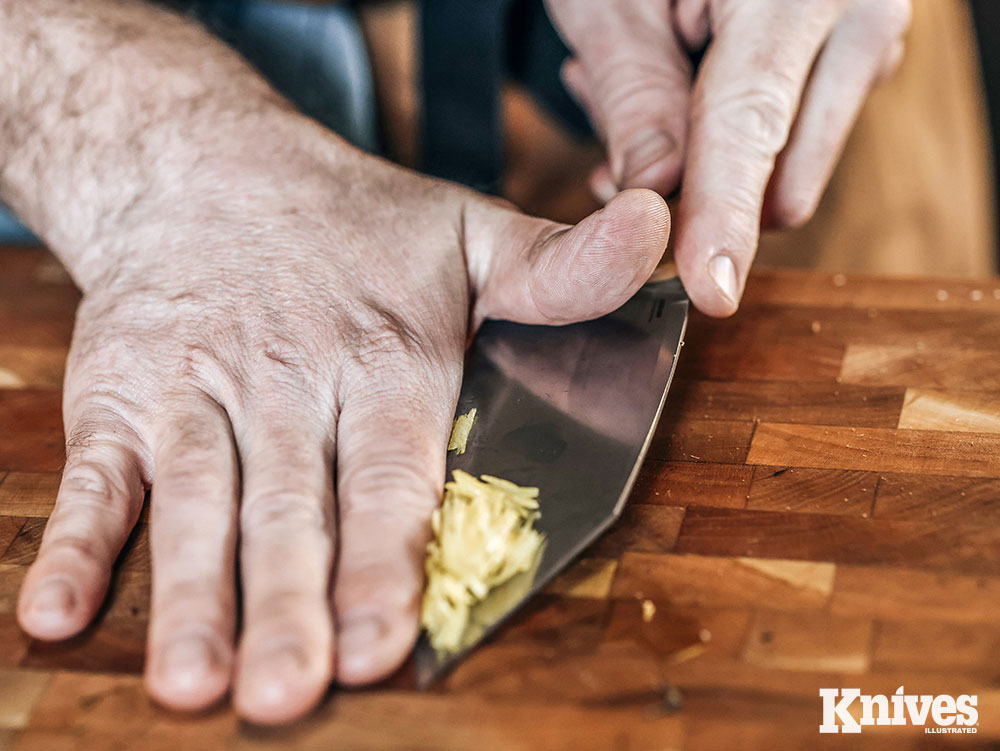
The wide blade of the Station Knife serves well as an improvised spatula for scooping ingredients from the cutting board to the pan.
Mendenhall has had a lot of opportunities to put these knives to the test from the beginning. He estimates that he’s worked with Benchmade kitchen knives just about daily for more than a year. Also, he said the Benchmade design team did its job well, and he didn’t have a lot of changes to recommend. He said that when he got the first prototype of the Station Knife, the square spine began rubbing on his fingers during prolonged use.
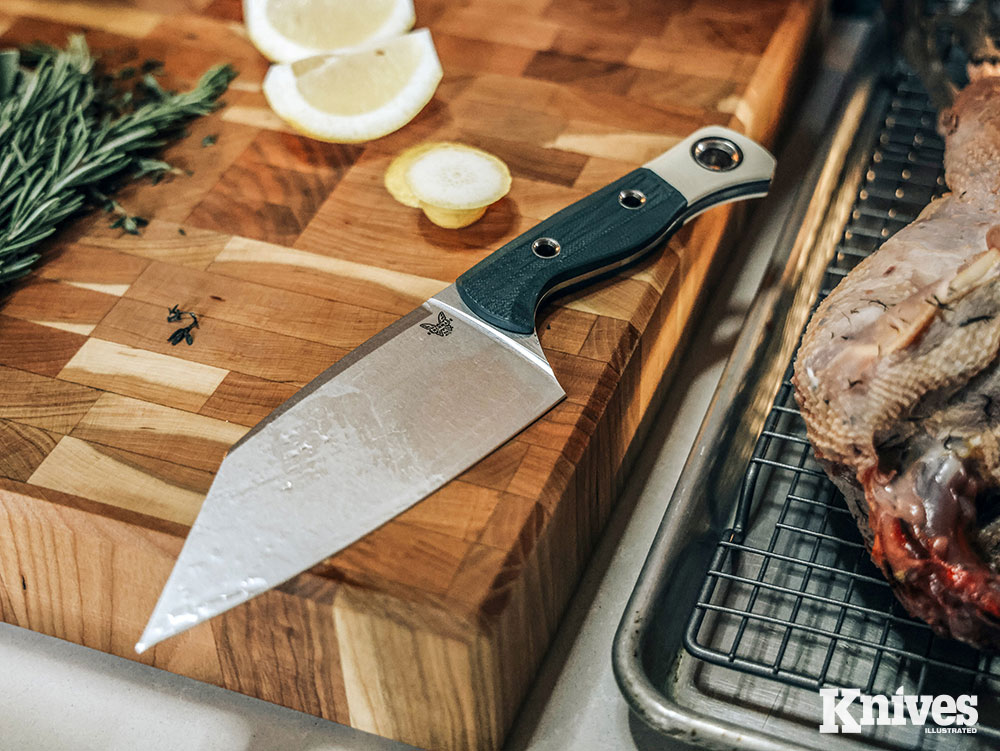
The shape of the Station Knife’s blade lends itself well to tasks for which you’d normally choose a larger and or smaller knife.
“This is very common with many knives, especially thick-bladed knives,” he said.
Mendenhall, like many chefs, likes to choke up on the blade and hold it between his thumb and index finger because that way the knife becomes a much more natural extension of his arm. He said that many chefs will develop callouses on their fingers as a result of this. He suggested that Benchmade round out the top of the spine.
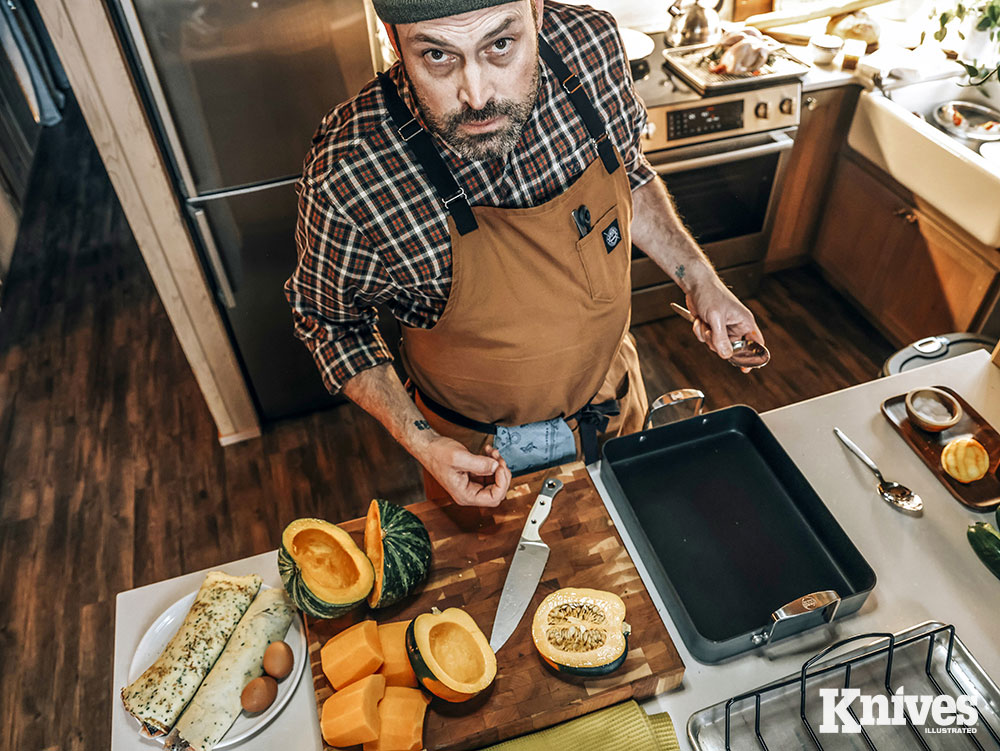
Executive Chef Kyle Mendenhall provided his input in the design of the Station Knife as it was being developed.
“The second version that came out actually had a little bit of a bevel on each side of the top of the spine that really helped to make that a bit more comfortable,” Mendenhall said.
He added that the Station Knife is aptly named.
“When you’re working in the kitchen, space is hard to come by,” he said.
He sees a big benefit in a knife that will allow you to do everything from cutting vegetables to slicing meat because you don’t want to have more equipment at your station than necessary.
“This (Station Knife) is a knife I would have at my station because it can cover a wide range of tasks. And, therefore, you’re more concise, you’re more organized.”
SPECIAL FEATURES
According to Mendenhall, the Benchmade Station Knife has some key features that help give it such versatility. First, it has a large handle—5 inches long and 0.608 inch thick—crucial according to Mendenhall. The thickness of the blade is very similar to a chef’s knife, which is the one you’re going to use for the majority of tasks in the kitchen.
At the same time, it has a handy, smaller length than a chef’s knife. Sometimes chef’s knives are quite long, making some work challenging.
“All the cuts were easy and the knife was a pleasure to use, not only because it was very sharp, but because it handled so naturally.”
Another key feature is the fine, pointed tip, which gives the Station Knife all the best attributes of a paring knife, a boning knife, or a filet knife. Because the angle is drastic to the fine tip, you can trim fat and clean sinew off meat or separate meat from bone without losing much meat.
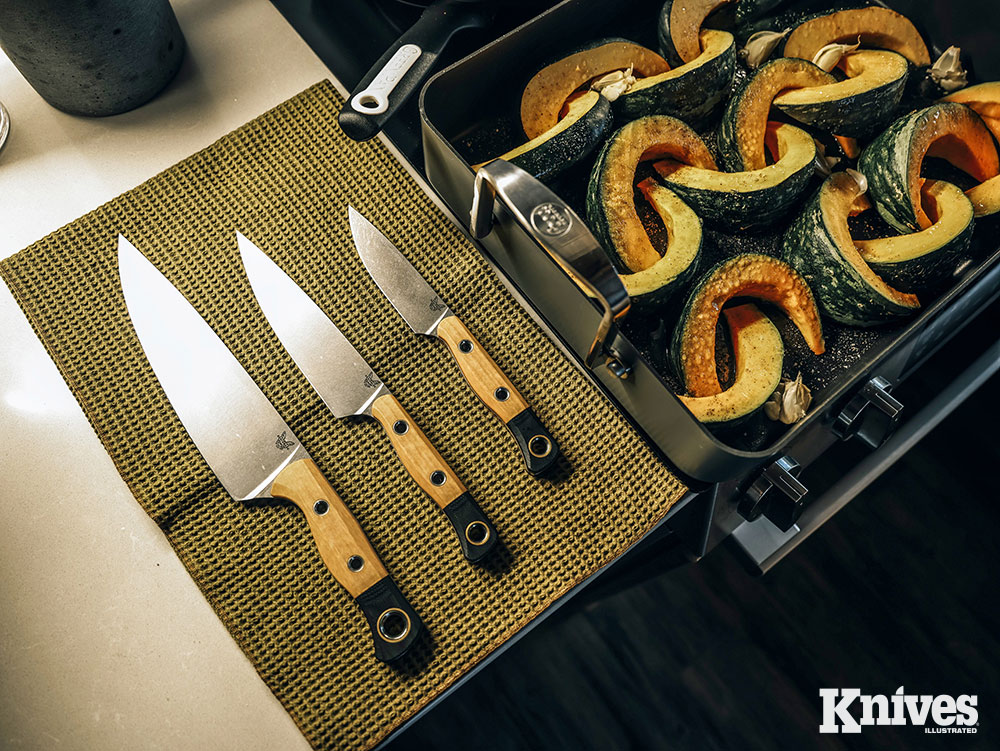
In addition to the Station Knife, Benchmade is offering a three-piece set, which includes a chef knife, utility knife, and paring knife.
According to Mendenhall, a benefit of all these features is that you don’t have to keep reaching for yet another knife while preparing the necessary ingredients. It has the ability to swing back and forth from the detail things such as taking out the core of a tomato to chopping a very dense winter squash.
“I have a lot of knives, but this is actually the knife that I carry around with me the most,” Mendenhall said. “So if I show up at any of the various restaurants we have and my help is needed in the kitchen, I know that I can do pretty much any task with this knife.”
GREAT OUTDOORS
Mendenhall sees the Station Knife as a good choice for outdoor use.
“Food brings everybody together,” he said. “A lot of what I really enjoy about the outdoors, whether it be hunting or hiking, is actually getting to your destination and then being able to prepare a meal. But being a chef, it’s never a meal just to get by. Being able to treat yourself to real gourmet food in the backcountry after you’ve been hiking is something that I’m very passionate about.”
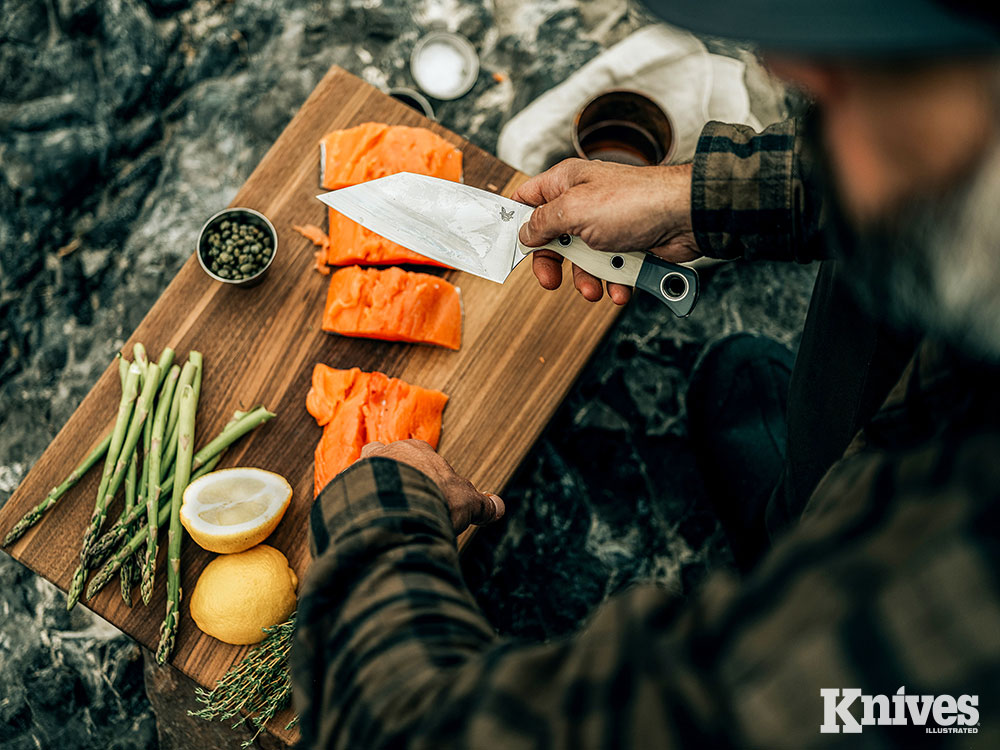
Your food prep duties don’t always have to take place in the kitchen. The Benchmade Station Knife is well suited as a versatile option for cooking outdoors without the need to bring a whole drawer full of knives.
But choosing a knife to take with you away from your kitchen requires a lot of thought because you have to consider how big it is, how much it weighs, and how you can have a knife that can cover a multitude of tasks so that you don’t have to bring three or four different knives with you.
“This is one knife that you can carry with you that’s going to cover 90% of what you need to do, everything from preparing vegetables, small and large in size, to cleaning meats, butchering meats, slicing meats.”
A bonus, he said, is that it comes with a durable sheath that’s easy to wash, so that you don’t have to have one custom made by someone else.
SHARP IDEAS
Making a knife that’s sharp and has the ability to hold that edge involves several factors, including the steel chosen, the heat treat, and the grind.
Mendenhall said that the option of getting the Station Knife made with CPM-154 steel bridges the gap between the Japanese knives that are extremely sharp and the German knives that are known for their durability.
“I’ve had this (Station) knife for probably six or seven months now and I’ve never sharpened it once yet,” he said. “And I’m the kind of person, being a chef, that if I don’t have a sharp knife, I don’t even want to cook. A sharper knife is a much safer knife because the blade is going to go where you want it to go. The scars I have on my hands and fingers are pretty much all from super dull knives.”
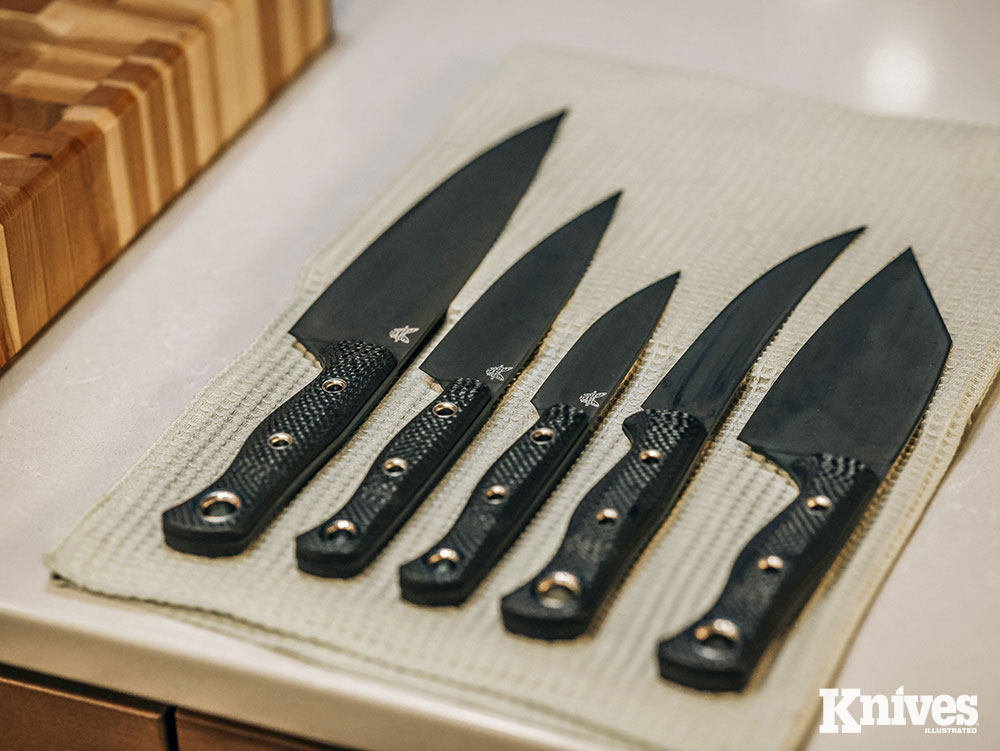
Why not get them all with matching blades and handles? Shown with the Station Knife (right) and Benchmade 3-Piece Set is the Meatcrafter boning knife (second from right). Missing is the Benchmade Table Knife.
The Station Knife’s sharp edge, he said, has a lot to do not only with the steel, but with Benchmade’s SelectEdge technology. The blades are ground at a 14-degree angle on each side. Benchmade’s research has shown that this gives them the best balance of sharpness and durability when the blades are used for push cuts, widely used in food prep.
So what happens when you do need to sharpen these Benchmade knives? You can play around with sharpening them yourself. But Benchmade’s Lifesharp program is probably the best way to go. Send the knives to Benchmade and the company will restore their factory edge at no charge.
PUTTING IT TO WORK
Of course, I had to try the Station Knife for myself. I decided to make some beef stew. This is a one-pot meal I might make in deer camp, but because I was cooking at home in a conventional oven this time, I opted to use one of my flat-bottomed cast-iron Dutch ovens rather than one with legs.
I used the Station Knife to chop carrots, celery, and an onion. Also, I used the pointy tip of the Station Knife to remove brown spots in the potatoes that I also chopped into bite-sized chunks. I never had to reach for the paring knife. I used the wide part of the blade like a spatula to scoop the ingredients off the cutting board and into the pot.
All the cuts were easy and the knife was a pleasure to use, not only because it was very sharp, but because it handled so naturally.
MAKE IT YOUR OWN
I like the way my Station Knife looks with its ivory scales and black bolster. But you’re not locked into that. You can customize any of the Benchmade kitchen knives by selecting options on the company’s website.
First choose between either CPM-154 or the more affordable 440C. You can have either with a polished finished or a black DLC finish. If you choose G10 handles, your color options are black, blue, ivory, forest green, cool gray, dark red, or jade. In Richlite handles, you have the option of blue canyon, redstone, or maple valley. There’s also a grayish black carbon fiber handle option. G10 tail end bolsters can be either black, ivory, or cool gray.
For the pivot ring at the end of the handle, you can choose from satin stainless steel, gold-plated stainless steel, black DLC stainless steel, or blue sapphire PVD.
If you want to go all in, there’s a collector’s edition model with a Damasteel blade that sells for $1,500.
WIDE APPEAL
When you decide to invest in quality kitchen knives, the Station Knife is a good first knife, especially if you can afford only to buy one piece at time and gradually build your collection over time.
For professional chefs and dedicated amateurs who relish basking in the heat of the kitchen, the Station Knife is handy as you don’t have to reach for different knives continually as you switch tasks.
For me, the appeal is that it makes a great camp knife for food prep. Even when I’m cooking at home, it’s with an eye for experimenting with recipes that can work on family campouts and at deer camp. I’m not going to bring a whole drawer full of knives. But I will bring the Station Knife, which will handle most of what I need to do in my improvised camp kitchen.
A benefit too is that, being a Benchmade knife, it’s made in the USA by a company that also makes some of my favorite EDC blades. While I own and enjoy knives from many different makers, there’s a nice, confident feeling when I pick up a kitchen knife that is made by the same people who make the knife I often carry in my pocket and depend on for daily tasks. I’m sure other people will feel the same.
SPECS
Benchmade Station Knife
Overall Length: 10.88 inches
Blade Length: 6.93 inches
Handle Thickness: 0.608 inch
Weight: 6.92 ounces
Other: Plastic sheath included
MSRP: $270-$535, depending on options selected
Benchmade 3-Piece Set 4020 Chef Knife
Overall Length: 13.02 inches
Blade Length: 8.04 inches
Handle Thickness: 0.608 inch
Weight: 7.37 ounces
4030 Utility Knife
Overall Length: 10.63 inches
Blade Length: 6.16 inches
Handle Thickness: 0.608 inch
Weight: 4.72 ounces
4040 Paring Knife
Overall Length: 8.78 inches
Blade Length: 4.3 inches
Handle Thickness: 0.584 inch
Weight: 3.52 ounces
MSRP: $720-$1,350 for all three, depending on options selected
THE NEXT STEP: Benchmade’s 3-Piece Set
If you’re more involved in preparing meals, exploring new recipes, and incorporating more ingredients, that’s when you might want to go beyond just the Station Knife and add more task-specific, specialized knives, such as those offered in the Benchmade 3-Piece Set.
The Benchmade 3-Piece Set includes a chef’s knife, utility knife, and a paring knife. All can be customized on the Benchmade website with the same features offered with the Station Knife.
According to Mendenhall, when you’re doing any specific task repeatedly, that’s when you want to break out the three-piece set to have the most appropriate tool for the job.
He said the Benchmade chef’s knife hits the target in the center, especially with its length and thickness, to cover most of what you’re going to do in the kitchen. The advantage with a chef’s knife over the Station Knife is that the longer blade—about 8 inches—makes long, repetitive tasks like chopping a great quantity of vegetables much less fatiguing.
The utility knife, with a 6-inch blade, is a good in-between knife, falling size-wise between the chef’s knife and paring knife. It’s especially good for trimming meats.
The paring knife, with 4-inch blade, is great for detail tasks. A nice thing about the Benchmade version, according to Mendenhall, is that it still offers an ample handle. Even though you’re using a smaller blade, your hand isn’t getting smaller. You still need a good, full-size handle to better grip and manipulate the knife. If you’re trimming or peeling a lot of fruits and vegetables, you’re going to want a paring knife.
“The tips on all of these Benchmade station knives are something that every chef wants because they come to such a fine point, but they have the strength and durability,” he said.
There are two more models currently in the Benchmade kitchen cutlery line. They are the Table Knife and the Meatcrafter. The Table Knife has a 5-inch blade and is available singly or in four-piece sets. The Meatcrafter has a 6-inch trailing point blade and can be used as a boning knife. What’s next in this impressive Benchmade line, a serrated bread knife perhaps?
SOURCE
Benchmade Knives
Benchmade.com

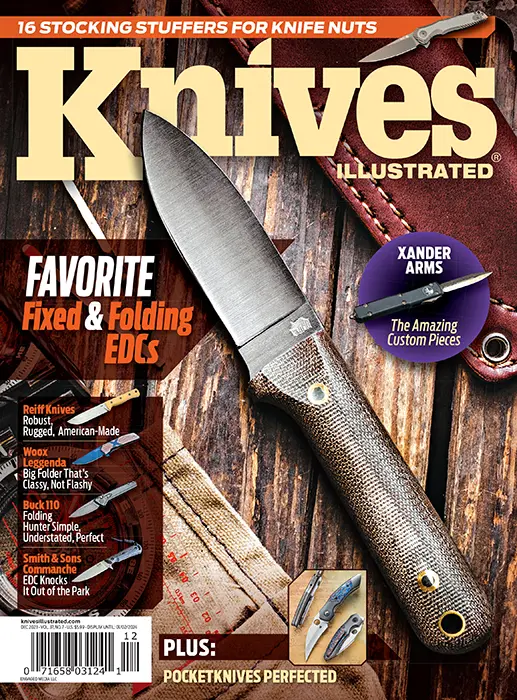 Subscribe / Back Issues
Subscribe / Back Issues